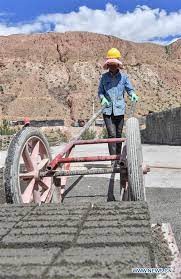…AND INTENSIVE URBAN CONSTRUCTION WORKFORCE TRAINING
Blog one in a series documenting China’s path to urbanising Tibet, depopulating the highlands, converting exnomads into infrastructure construction workers 1/5
ON THE SCAFFOLD: CONCRETISING TIBET
Recent commentary on Tibet and Xinjiang, similarities and differences, focussed on labour mobilisation. Key question: are Tibetans being pushed off their pastures and into factory work, and the urban construction workforce?
This blog seeks to clarify that debate, which has been lacking documentation. This is a dive into the evidence.
Key policy statements analysed here include:
- the TAR 14th Five-Year Plan for 2021 through 2025,
- recent draft revisions to the Vocational Education Law,
- China State Council White Paper on Tibet 2021,
- an April 2021 detailed plan for displacing more nomads from their lands and into urban construction, issued jointly by the TAR Departments of Housing and Urban-Rural Development, Human Resources and Social Security, Transportation, Water Resources Department and Federation of Trade Unions of Tibet Autonomous Region.
Tibet Autonomous Region is serious about urban construction, so serious most of the region’s 14th Five-Year Plan is devoted to an unusually detailed roadmap of how to crank up a construction industry that delivers at scale, on time and within budget, operating year-round, eliminating widespread graft, making the dams, bridges, factories, apartment towers and other structures, conforming to earthquake-ready standards.
Since there is a long list of constraints on concreting Tibet at the pace Beijing now demands, command of the construction sector is now imperative, if the hold of the gangmasters and tofu builders of substandard structures is to be disciplined to conform. The regional government, although seldom assertive, is in command; the piper calls the tune.
The TAR government’s will to power may cut through the bottlenecks and chokepoints of an industry of Sichuan based contractors coming to Tibet to make quick money by cutting corners, compromising quality, hiring only from within its own networks, grifting wherever it can get away with it.
TAR’s newfound will to accelerate urbanisation across central Tibet is, however, not enough to succeed. If Beijing’s mandatory leap forward is to happen, there needs to be a new, magical ingredient: a Tibetanised workforce, willing to work hard at altitude, year-round.
For Tibetan men, and a few women, construction work is not new; but it has been poorly paid, precarious, with employers, contractors and sub-contractors routinely flouting laws that protect occupational safety, working conditions, even the use of scaffolding. Construction work has been a prime source of off-farm income, usually in the summer, the very time farmers need all hands to harvest and thresh crops; when pastoralists need to fan out their herds to feast on upland alpine meadows, to fatten up after the long winter.
For decades, the fit young men of Tibet have availed of this dangerous, precarious, gig economy work, because there was little choice, and pastoralists, constrained by Chinese controls on herd size and land tenure size, were getting poorer. For decades this haphazard system worked. Tibetans privately complained of being treated as outsiders in their own lands, treated as expendable by the gangmasters, and as strictly temporary urban dwellers by the official minders of the hukou household registration system.
Now China, in a new era, is in a hurry to urbanise not only Lhasa but also Shigatse and Lhoka prefectures as well, to catch up with the urbanisation rate of lowland China, to put an end to the embarrassing ways central Tibet lags all provinces.
These are powerful drivers for a whole-of-government reboot of the construction industry, to ensure much more gets built quicker. For Tibetans, this means long term urbanisation of entire rural families, training of a Tibetan construction workforce, cancellation of rural land tenure rights, mandatory schooling in putonghua Chinese as the language of construction, depopulation of the pastoral lands, intensified agribusiness factory farm feedlots to get more meat protein to Chinese markets while employing fewer Tibetans.
This will not happen overnight, it is a five year plan, but the direction is clear. If these plans are realised, the impact will be profound. Since Adrian Zenz, in September 2020, issued an alert that labour mobilisation of rural Tibetans is intensifying, there has been debate as to whether Tibet is now similar to Xinjiang, or maybe nothing much is happening, beyond work units registering Tibetans as trainees. The question of evidence of an expanded labour market in Tibet has been problematic. Yet the obvious source is the TAR provincial Five-Year Plan, which is the surest guide to China’s intentions. It is analysed here.
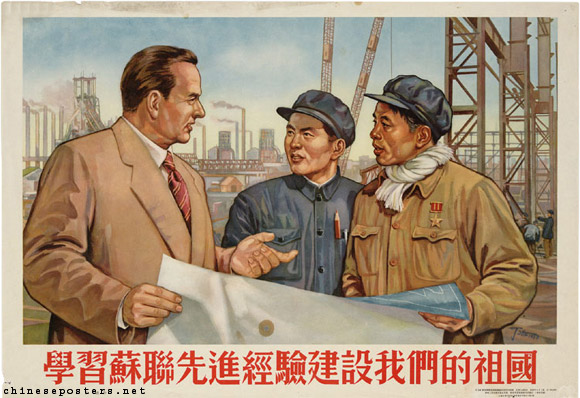
ACCELERATING TIBET
This is what the TAR 14th Five-Year Plan (FYP) says: “Guide the construction and engineering enterprises in the zone through capital operation, M&A [corporate merges and acquisitions] and reorganization, separation of main and subsidiary companies, equity incentives and other methods to develop a group of Han nationality joint ventures and various nationality unity and cooperative enterprises, accelerate the transformation and upgrading of construction enterprises, and promote enterprises to be better and stronger. Promote the optimization and adjustment of corporate structure, track the direction of qualification reform, and guide and promote the qualified.
“The joint reorganization of the general contracting enterprise of the project with the survey and design, project management, investment and financing services and other enterprises, expand the upstream and downstream industrial chain and cultivate general contracting of projects that integrates investment, design, construction, and operational enterprises, increase the industrial concentration of the construction industry; prosper the construction subcontracting market, and support the development of competition in the whole region.
“Specialized enterprises with strong competitiveness and obvious characteristics, focusing on Shigatse and Shannan [Lhoka in Tibetan], developing entities of labor service enterprises; promote the transformation and upgrading of construction teams of farmers and herdsmen, support farmers in the district, and herdsmen’s construction team to develop towards professionalism and standardization, through reorganization, joint operation, joint-stock cooperation, attract craftsmen from farming and pastoral areas to guide them to majors in construction enterprises, labor service enterprises, and ancient (Tibetan) architecture enterprise development, through the revocation of illegal qualifications.”
This is a comprehensive menu for creating a regulated, supervised Tibetan construction workforce, also with Tibetan corporations competing with the incoming Sichuanese. It’s a five year agenda for a lot more than the “formalism” of enrolling rural Tibetans in phantom vocational courses that don’t really happen, yet still generate net profit for Han training providers.

SCAFFOLDING A NEW TIBET
The drive to intensify construction of Ȗ-Tsang requires a drive to train a new construction workforce. The TAR 14th Plan has much to say on this:
“Carry out practical construction skills training. Vigorously implement the skill improvement project for farmers and herdsmen, and establish education and training mechanism for migrant workers, improve the quality of migrant workers, give them opportunities for development, and improve the degree of organization of the transfer of employment of farmers and herdsmen, making construction workers an important impetus for the coordinated development of urban and rural areas.
“Organize training through various levels of housing and urban-rural development departments. Migrant workers bring in more local migrant workers, self-training by enterprises, order-based training, etc.
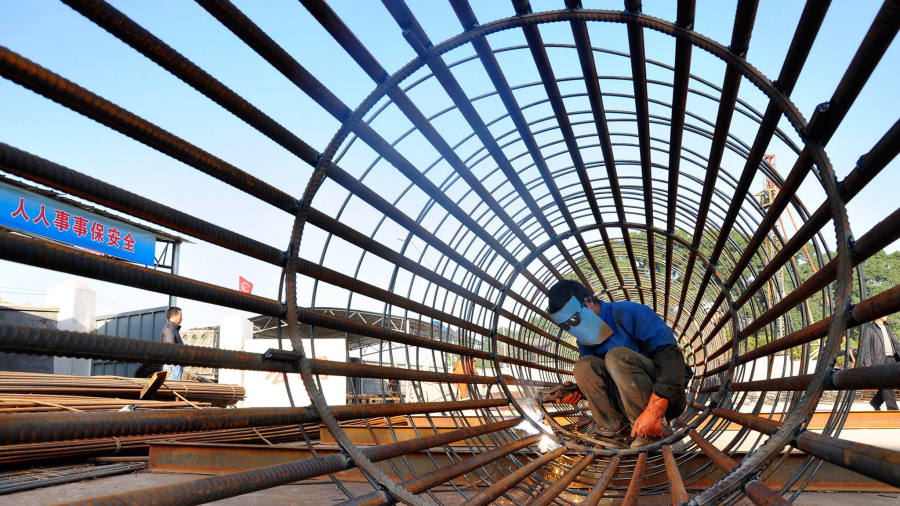
“Farmers and herdsmen at the level of modernization focus on training as construction site managers, and for those who have been employed in the construction field for a long time
“Farmers and herdsmen, increase the training of practical skills, and focus on increasing the willingness to work in the construction field for a long time.
“The training intensity of farmers and herdsmen, comprehensively improve the skill level and quality of farmers and herdsmen, so that they can convert into construction industry workers. During the “14th Five-Year Plan” period, strive to pass three-year training.
“The number of farmers and herdsmen migrant workers in the region accounted for more than 30% of the local migrant workers, persisting for a long time, and increasing year by year. Promote the industrialization of construction workers. Reform the construction employment system and encourage construction enterprises, the industry trains and absorbs a certain number of self-skilled workers.”
This looks like an agenda for training as an industry in itself, with a three-year syllabus, ending in certification, which also absorbs Tibetans with existing on-the-job skillsets, who are accredited for prior skills learning. Training, if it does become an industry, is highly unlikely to write its syllabus in Tibetan, and would most likely employ Han to instruct enrolees not only construction industry skills and protocols but also in Chinese language proficiency as a foundational prerequisite. Establishing a full three-year program by 2025 is the official goal.

The TAR 14th plan often mentions migrants coming into the construction industry, who in turn encourage more to migrate from rural Tibet into urban training and industry employment. Migrants could also come from other provinces, but the emphasis seems to be on depriving rural Tibet, always facing labour scarcity, of the fittest young men.
Implicitly, the entire program is gendered to favour fit young men, leaving behind all others in a hinterland lagging ever further behind, in underinvested farms and pastures. For decades, casual construction work has provided mobile young men their best chance of off-farm income. Now that established informal system is being formalised. Whether the young men share or squander their earnings will be up to each to choose. Migration always loosens social bonds.
TAR 14th Plan: “Strengthen the construction of high-level talent teams. Increasing the number of corporate managers and high-end talents. Training to improve the application of modern enterprise management, general engineering contracting, whole-process consulting, prefabricated construction. Advanced management models and emerging construction technologies such as new infrastructure, green buildings, green construction, and smart construction.”
“Clarify goals and tasks, and establish a long-term mechanism for the training and development of intelligent construction talents. Organize on-site observation meetings and training to improve the understanding and business level of prefabricated buildings, and through appropriate methods, the hoisting of prefab panels, special skills training for prefabricated construction such as grouting and welding will be carried out.
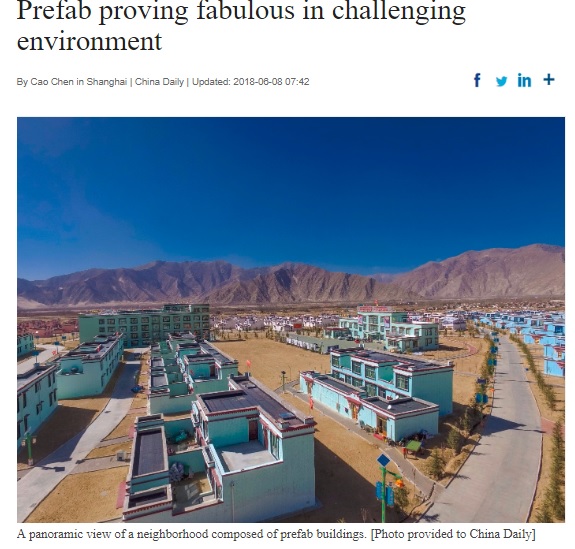
A FIVE-YEAR PLAN WITH PURPOSE
Of the 39 pages of the TAR FYP, 24 are dedicated to just this one topic, far too much to quote here. Five-Year Plans are sometimes vague about how ambitious goals will be achieved. This Plan is unusually detailed, defining who the new workers will be, what capitalist corporate models the employers will adopt, who has legal authority to regulate them; in short a full labour market plan for a construction boom beyond anything Tibet has so far seen.
More from the TAR FYP: “Farmers and herdsmen construction enterprises are appropriately supplemented with reasonable layout and distinctive features, a distinctive industrial structure with complementary advantages. Make the private economy the fastest-growing important market force. Let state-owned enterprises have stronger competitiveness in bidding for projects, especially major projects. a new business development model will be formed, the industrial level will be improved, and the construction industry chain will be lengthened. The industry strengthens capital operations, adopts BT, BOT, PPP and other models to support the development of general contracting business for projects, focusing on Lhasa, Xigaze [Shigatse], and Shannan [Lhoka], guide and support the Construction Engineering Building Materials Group, Lhasa Urban Investment, Xigaze state-owned enterprises such as Everest Urban Investment, Shannan Yalong Investment Company and powerful enterprises give full play to their own advantage, the establishment of an integrated enterprise of financing, construction and operation, taking prefecture (city) as a unit, participating in the city and town infrastructure, sanitation infrastructure, new-type urbanization, border areas and other projects financing investment”
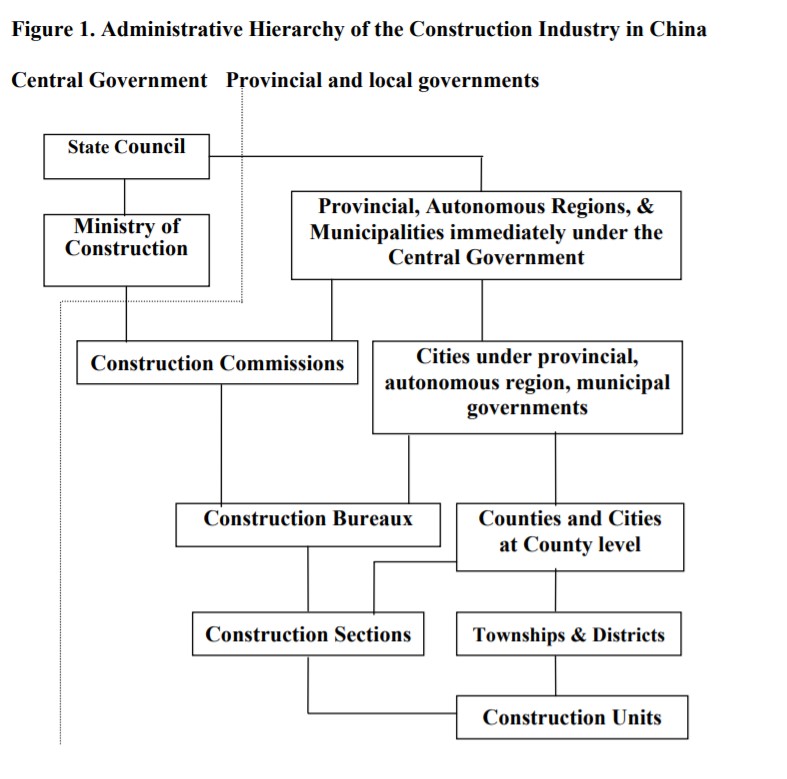
This is the developmentalist state at full pitch, picking winners named in advance as the favoured candidates to lead the construction boom financed from Beijing. Profit is guaranteed upfront, by encouraging bidders to go for enterprise models designed to lock in profitability: BT, BOT and PPP. [build and transfer, build, operate and transfer, public private partnership].
All these options are designed as deals binding contractors and the party-state financiers in which the nation-building state pays an agreed premium price, assumes much of the risk, supplies the finance at concessional rates and, where the new construction generates revenue, allows the builder to also operate the hydro dam or tollroad, collect revenue for decades, transferring ownership to the state only when the facility is old. Since the named preferred contractors is all state-owned, the party-state is effectively deepening a rentier economy, ensuring its trusted friends a guaranteed high rate of return. It doesn’t look like a new era. This looks like the old, entrenched crony capitalism.
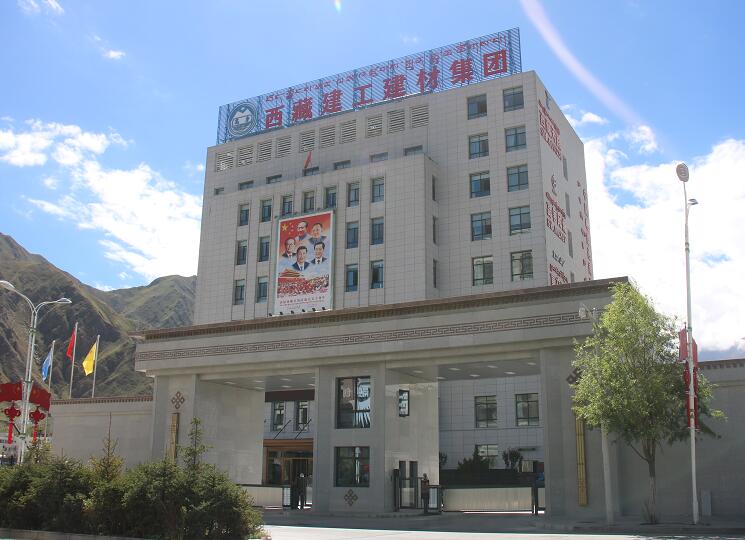
But all of this starts with recruiting those farmers and herdsmen about to become redundant, as the countryside empties and meat production is concentrated in feedlot enclaves. Labour, always scarce in Tibet, a land as big as Western Europe with (until extremely recently) no more than six million humans, is about to become even scarcer in the countryside. Rural stagnation and decline will ensue.
The TAR 14th Five-Year Plan was made public early January 2021. Lest anyone suppose this Plan, as with past Plans, is full of utopian rhetoric that seldom is implemented, four months later a more specific directive was issued by all departments responsible for implementation – TAR Departments of Housing and Urban-Rural Development, Human Resources and Social Security, Transportation,, Water Resources.
This too is far too long to quote in full, over 7000 characters. Its title is Implementation plan for Tibet Autonomous Region to accelerate the cultivation of a new era construction industry worker team,西藏自治区加快培育新时代建筑产业工人队伍实施方案, Xīzàng zìzhìqū jiākuài péiyù xīn shídài jiànzhú chǎnyè gōngrén duìwǔ shíshī fāng’àn.
This Implementation Plan aims to transform Tibet: “building an army of knowledge-based, skilled, and innovative workers, promote the reform of the construction industry’s labor employment system, strengthen the construction of the construction industry worker training base for the new era, and increase the construction industry’s agriculture and animal husbandry emigrant workers’ training efforts, improve the supply of skilled personnel in the construction industry, open up career development channels for construction workers, protect the legal rights and interests of construction workers, and accelerate the cultivation of a new era of construction industry workers.”
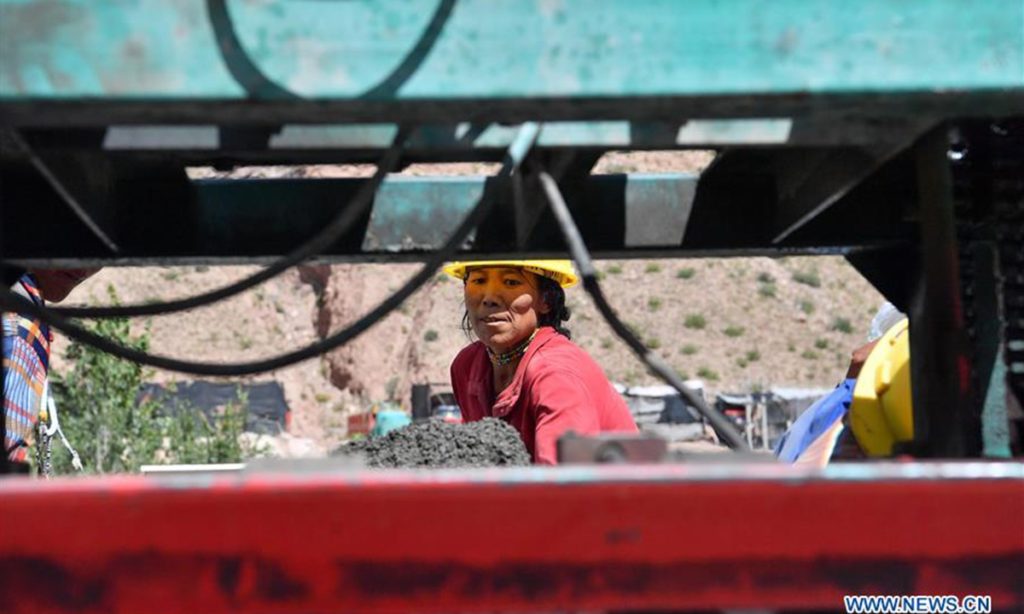
The wordiness of this decree paints a utopian picture of a highly trained, accredited, regulated and certified workforce, which also has a place for the lesser skilled ex-nomads: “Encourage the localization of construction industry workers. In order to save social costs, facilitate workers’ entrepreneurship and employment, reduce the mobility of construction workers, and improve their professionalism and sense of belonging, in the newly started projects, the localization and innovation of professional operation enterprises will be tried, and the labor operations will be subcontracted to professional operation enterprises in our region. Some types of skilled workers can adopt the ” local + foreign ” combination model to achieve ” passing, helping, and leading ” in the way of “mentor and apprentice” to help the development of local industrial workers. It is necessary to gradually establish a directory database of professional operation enterprises, and support general contracting enterprises to preferentially select professional operation enterprises in the region, and projects with low technical requirements can choose the construction team of farmers and herdsmen workers in our region to participate in the construction.”
This suggests an expanded credentialism, requiring years of apprenticeship in training programs run by the issuing departments, followed by more years on low pay as apprentices to those “foreign” skilled workers from other provinces. This could readily become a curriculum for civilising those backward herders, inducting them not only into construction-specific skills, but into a wider syllabus of behavioural training in showing appropriate gratitude to the party-state that has rescued them from their pasturelands.
That could take years to eventuate. Before the displaced graduate as qualified construction workers, the new vocational schools must be built, and staffed by Han who understand how to educate the desire to become competitive, in a highly competitive society.[1] Credentialism is an ideology that takes itself very seriously, with Key Performance Indicators tested regularly, standardised tests, and regular exams, all conducted in standard Chinese, which is likely to require a foundation year of putonghua standard Chinese instruction.
This could well be a substantial new industry for TAR, not only in Lhasa but in Shigatse and Tsethang as well, aiming at the elaborate transformation of illiterate herders into model construction workers, who know their place, accept discipline, and are positioned on the bottom rung of the ladder of human capital formation.
SINEWS OF MODERNITY, RIVERS OF CONCRETE
This Plan isn’t only about urban infrastructure construction but also the networks of commodities that must flow to the expanding municipalities that have replaced those nominally autonomous prefectures in the targeted areas. Fast growing cities need reliable electricity supply, cabled internet connectivity, plentiful clean water, and fast tollroad highway and high-speed rail connections to the markets of lowland China, if they are to grow apace, and prosper. Taken together, this is a big agenda, but this FYP explicitly includes all the above.
All infrastructure construction needs the cement, sand and gravel for concrete; the steel for framing and reinforcing, the glass for the look of modernity. The fast growing TAR minerals extraction industry is even more power-hungry, and in need of advanced equipment made in Europe, such as AC/DC transformers and rock crushers bigger and more powerful than those made in China. These can all be procured. Cement is now the lead industry in Tibet, having scaled up at an extraordinary rate. Cement is now such a big industry, Lhasa has outgrown the old cement factory in town, for a much bigger site further out, with plans for the old factory to become an art museum:
The newer cement factory at Dongga to the west of Lhasa, is immediately upwind of Drepung monastery and then Lhasa city. The energy-intensive kilns that turn crushed limestone to cement are powered by the Dongga coal-fired power station next door, major contributors to air pollution in Lhasa. (Zhiyuan Cong, et al., Trace elements and lead isotopic composition of PM10 in Lhasa, Tibet, Atmospheric Environment, 45, Issue 34, November 2011, Pages 6210-6215)
As with all party-state mass mobilisation campaigns, this will be an arduous struggle: “Strengthen vocational skills training in the construction industry. Establish a construction worker vocational education and training system with the participation of industries, enterprises, colleges, and social forces, and adopt a mode of combining offline and online to provide practitioners (employees) with multi-channel and multi-type continuing education resources. It is necessary to make good use of the employment and entrepreneurship subsidy funds and various vocational training funds. Vigorously implement the skill improvement project for farmers and herdsmen workers, establish an education and training mechanism for farmers and herdsmen workers, improve the quality of farmers and herdsmen workers, give them opportunities for upward development, improve the degree of organization of the transfer of employment of farmers and herdsmen workers, and let construction workers become an important driving force for urban and rural coordinated development. Through various methods such as training organized by the competent departments of the industry at all levels, training on behalf of the job, masters leading apprentices, inland migrant workers leading local migrant workers, enterprise self-training, order-based training, etc., we focus on training farmers and herdsmen with a certain level of education as the construction site managers, increase the training of practical skills, focus on increasing the training of farmers and herdsmen who have long-term employment in the construction field, and comprehensively improve the skill level and quality of farmers and herdsmen, so that they can transform into construction industry workers as soon as possible.”
As in other campaigns, propaganda plays a part in mobilising enthusiasm for making Tibet an authentic replica of urban China. Propaganda mobilises the masses, instils a sense of pride, rewards the few deemed “model workers”. “Vigorously promote the spirit of model workers, labor spirit and craftsman spirit. Adhere to the correct guidance of public opinion, publicize and interpret the significance, objectives, tasks, and policy measures of the construction worker team building reform, and timely summarize and promote the good experience and good practices of the construction worker team building reform. Intensify the publicity of the selection of model workers for construction workers, vigorously promote the advanced models in the team of construction workers, and create a good atmosphere of the most glorious work, the most noble work, the greatest work, and the most beautiful work. Do a good job in publicity services. All localities should vigorously publicize the significance, urgency and policy measures of cultivating the construction industry worker team in the new era, and make full use of various media to publicize the contribution of construction workers to economic construction, so that construction workers can fully enjoy the pride and contribution of realizing their own value. A sense of social accomplishment, a sense of honor to be respected by the society.” Will the displaced go for it? Will Tibetans acquire useful skills? Will the skills of construction work be needed tomorrow, as mechanisation replaces skilled trades? Will vocational education be added to mandatory kindergarten, junior schooling, middle and senior secondary schooling, as essential credentialling of Tibetans? Will construction industry trainees accumulate cultural capital, and equality with Han?[2]

[1] Kipnis, Andrew B. 2011. Governing Educational Desire: Culture, Politics, and Schooling in China. Chicago: University of Chicago Press
[2] S Guan and E. Blair, Adult higher education as both an ‘opportunity’ and a ‘trap’: student perceptions on credentialism in China, Studies in Continuing Education, 2021, https://doi.org/10.1080/0158037X.2020.1867092

